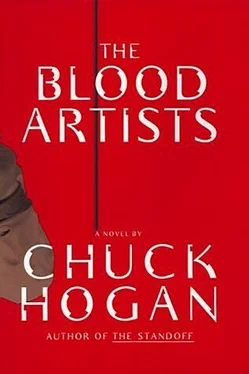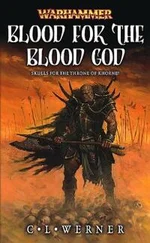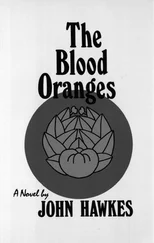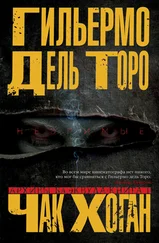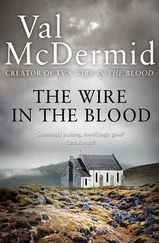He peeled open the tent fold on his side and entered, and I did the same opposite him. Resealed, it was quiet inside but for the hiss of oxygen.
The patient was a woman in her late thirties. The wrinkled sag of her biceps over the bedsheet indicated years of atrophy, though overall the condition of her face and hands evinced care. Her head rolled slightly on her withered neck, illustrating the benefits of dedicated physical therapy.
Her eyes were open and blinking and blushed faintly with hemorrhaged blood. She was early stage, the skin on her face dark and blotchy, her tongue — she was attempting to speak — scarlet and swollen. She looked up at the roof of the opaque plastic tent as though she were falling through the room rather than lying in it.
When she spoke, her unused jaw moved side to side rather than up and down, and her throat rasped hoarsely. “What is happening?” she said.
Tenney was punching up her chart on the bed rail console. “Negative for motor activity and speech functions for eighteen years,” he told me. A moment to do the math, then excitement in his eyes. “Since 1998.”
“What are you?” she said.
I released and collapsed the railing and sat on the mattress next to her. My suit bunched beneath me, but she was small on the bed and there was plenty of room. Tenney said revelatorily, “She’s never seen a contact suit.”
I nodded to quiet him. “My name is Dr. Stephen Pearse,” I told her. “You are in a federal hospital in South Carolina.”
I had to strain to hear her. “Why?”
“Well, you’ve been asleep for a while.”
She swallowed clumsily and raised her quivering right forearm off the bed, high enough that the orange hospital bracelet slid down to her elbow. “See?”
Soft, russet-colored lesions blemished her neck and face, but a bedsheet covered her body from the chest down, and her hands and arms were as yet free of any Plainville sores. I realized she was in fact directing my attention to her wrinkles.
She said, “Old.”
I watched her face as its features, fixed for two decades, shifted slightly with the effect of breaking apart, like ice cracking in warm liquid. They re-formed again in an awkward, lopsided, plaintive expression, and I recognized a teenager’s fear in an adult woman’s face.
I took her shaking hand and eased it back down onto the bed, and she gazed up at me, patient to doctor. “Parents,” she rasped.
“We’ll check,” I said, and the veneer of her face broke again into another long-unused expression. She wept tearlessly with the fragile eyes of a young girl. I squeezed her hand again. “We’re going to need to draw some blood. Then we’ll see about getting in touch with your folks.”
I motioned for the apparatus and Tenney handed it to me across the bed.
It had been a while. I swabbed her elbow and tied and released the rubber tourniquet, drawing out 4 cc as she moaned in pain. Her blood was dark and sludgy. I withdrew and broke off the needle and disposed of it in a biohazard box behind the bed, capping and sealing the syringe barrel. The motions were familiar to me, comfortable. Tenney printed a label from the bedside chart, and we met outside.
“Take care of the blood,” I told him, “then see what you can do about her parents.”
He appeared confused. “I’ve got rounds to do, sir.”
“Find them,” I said. “The hospital will have records. Leave your cart for me.”
He went away and I proceeded to a standing pan of Pheno disinfectant — green-hued, like a bowl of antifreeze — to immerse my gloved hands in the sterilizing solution between patients.
Plainville held tightly to its secrets. We could study it in only the most secure laboratory setting, and we could not work with it at all. The virus ate through laboratory animals, fetal tissue, Vero cells, and blood products — any living matter placed in front of it. Only through due diligence on the part of the bureau, as well as some extraordinary good fortune, had the bug failed to achieve amplification beyond the isolated microbreaks since Plainville.
As I was shaking out my gloves over the pan, I heard a muffled voice call my name. I was startled, but not unnerved, and looked around expecting to see another hopeful face inside a suit hood. There were no suits near me. I saw then a small, thin arm moving within a plastic tent, in bay number twenty-six. I went there, unzipping the tent and drawing Tenney’s instrument cart in behind me.
Patient Twenty-six was a younger man with a gaunt, collapsing face. I guessed he was in his late twenties, although the disease had aged him significantly. He was mostly bald, with a few patches of wispy silver hair streaming off his pate, as light and thin as spider’s thread. Overall, even as compared to the woman in twenty-five, Twenty-six’s convalescent care had been superlative. Only his sclera, the whites of his eyes, which were a bright firehouse red, indicated any significant illness. He bore no observable sores, save his badly scabbed, lips, which were nearly chewed away, as though he had been gnawing at them throughout his prolonged slumber.
But this man had been in a catatonic state for at least ten years. It was inconceivable that he should know my name.
“Do you know me?” I said to no response or change of expression. Just a hollow stare. The wasting man looked at me across a great distance, as though the center of the hospital bed were quite removed from the sides. I felt no recognition myself. I broke from the man’s stare and turned to the chart on his bed rail.
The screen read “Unoccupied.” I checked his thin wrists for an admittance bracelet, not finding one. His left arm was as light as a cardboard tube and I rotated it in search of a needle stick from a previous blood draw. The man did not otherwise move.
“What is your name?” I asked.
“Pearse,” he whispered again, in a garbled voice. He was staring at my chest, and I realized that my name tag was there. I turned and surveyed the outer room through the thick plastic tent, where yellow suits moved about hazily. He could not have read my name tag from that distance, and only barely could have made out my face.
“Who are you?” I said again, but his eyes had retreated into a faraway, blood-sodden gaze. I gave up and printed out an Unoccupied label, then proceeded to swab the man’s elbow with alcohol. I was still a bit rusty, and it took me three attempts to locate a viable vein for a blood sample. I released the tourniquet and watched the plastic barrel slowly fill with blood.
It happened in an instant. One moment I was finishing off the blood draw; the next, the syringe was falling from my hand, and there was a stinging in the center of my left palm. A shudder or a jerk, that by the laws of atrophy the patient should never have been able to make — and somehow his hand had come up and struck mine just as I was withdrawing the needle from his arm.
Afterward I stood for some time staring at the man beneath me. He had settled back into the mattress, the blood-filled syringe lying alongside his leg. His face was fixed and phlegmatic, his half-open eyes regarding me as though with a blithe red wisdom. All I kept thinking was He should not have been able to move like that.
Finally I left the staring patient and broke away from twenty-six. I threw aside the curtain and rounded the crowded nurses’ station, entering the air lock leading back out to the corridor. Lamps of deep blue light came on inside the chamber, and doors on either side of me bolted automatically. I had forgotten about the ultraviolet light shower. I tried the second door anyway with my right hand, a wasted effort. It was locked fast. I drew my left hand into a tight fist, and it felt inconceivably warm and heavy; I imagined my glove filling with blood. I closed my eyes and stood for 120 seconds as the blue light cooked the viruses on my suit.
Читать дальше
